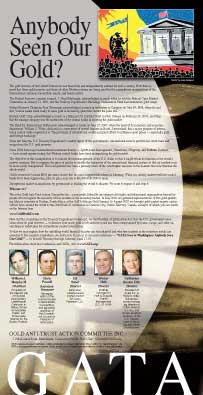You are here
Mark Gilbert: Pervasive intervention makes it impossible to value anything
From GATA's Washington conference, April 18, 2009
"The problem with central banking has been mainly the old problem of power -- it corrupts.
"Central bankers are supposed to be more capable of restraint than ordinary politicians, and maybe some are, but they are not always or even often capable of the necessary restraint. One market intervention encourages another and another and increases the political pressure to keep intervening to benefit special interests rather than the general interest -- to benefit especially the financial interests, the banking and investment banking industries. These interventions, subsidies to special interests, increasingly are needed to prevent the previous imbalances from imploding.
"And so we have come to an era of daily market interventions by central banks -- so much so that the main purpose of central banking now is to prevent ordinary markets from happening at all."
* * *
From GATA's presentation at the New Orleans Investment Conference, October 8, 2009
"For even as the price of gold has been rising, we really don't yet know what a fair price, a free-market price, for gold is, since gold has not traded in a free market for many years. Indeed, since central bank intervention in the currency, bond, and equities markets has exploded over the last year, we don't really know what the market price of anything is anymore. Thus this is a story about the valuation of all capital and labor in the world -- and whether those values will be set openly in free markets, the democratic way, or secretly by governments, the totalitarian way."
* * *
Valuing Bonds, Dollar Is Crazy in a World Gone Mad
By Mark Gilbert
Bloomberg News
Thursday, November 5, 2009
http://www.bloomberg.com/apps/news?pid=20601039&sid=a_GAssrewg9I
"In price is knowledge," an editor used to scream at me. Whether or not you believed in efficient markets, you could be sure the price of a bond, a currency, or a commodity was trying to tell you something about the outlook for growth, inflation, or monetary policy. All you had to do was listen and translate.
Not anymore. The ad-hoc combination of quantitative easing, government stimulus packages, and zero-interest-rate policies has distorted markets beyond recognition.
In short, it is almost impossible to make a coherent argument for what a 10-year Treasury should yield, what a dollar or euro is worth, or whether to buy or sell copper or gold. Following are examples of markets driven mad by the recent enthusiasm for government intervention.
1) Unshackled from Bondage, Unhinged from Reality
The 10-year U.S. government bond yields about 3.5 percent, down from a five-year average of 4.14 percent and its 20-year average of 5.57 percent. Today's level, though, is about as reliable as the price of a collateralized-debt obligation in the depths of the credit crunch.
The combination of U.S. authorities keeping the fixed- income market on life support by buying debt, plus commercial banks filling their balance-sheet holes with top-quality government securities, makes the Treasury yield an exercise in marking-to-myth.
With bonds as your guide, you would never guess that the U.S. Treasury plans to borrow a net $276 billion for the October-December period and a further $478 billion in the first quarter of next year, or that it expects to hit its $12.1 trillion debt ceiling some time next month.
If anyone is worried that the multitrillion-dollar global Keynesian experiment we're in the middle of might backfire and ignite inflation, they haven't told the Treasury market. Maybe they have been whispering instead to the gold market. Gold has reached a record $1,095 per ounce this week after a 25 percent gain so far this year. You know markets have gone mad when the 10-year Treasury couldn't care less that gold is at a record.
2) Credit Where It Isn't Due
Investors who own European corporate bonds have made more than 15 percent this year on a total-return basis, according to figures compiled by Deutsche Bank AG. Subordinated debt sold by financial companies has delivered more than 26 percent. In Europe's high-yield market, junk debt has returned a spectacular 67 percent.
You will struggle, though, to find anyone who trusts the rally. Too much money, with nothing better to buy, indiscriminately rushing back into the credit markets -- that seems to be the culprit. Never mind that the default rate among high-yield companies in Europe reached 9.3 percent at the end of the third quarter, up from 6.4 percent in the previous three months, according to Moody's Investors Service.
The rating company is predicting speculative-grade bond failures will peak at 10.9 percent this quarter, before almost halving to 6 percent a year from now. That seems way too optimistic, given the economic carnage wreaked by the credit crunch on corporate creditworthiness.
You know markets have gone mad when corporate bonds promise equity-style returns. It can mean only one thing: Investors should brace themselves for the equity-style risk of losing all of their money, not the security of regular interest payments.
3) Currency Carnage
The Japanese economy has been a basket case for years, with a second-quarter gross-domestic-product performance that was downgraded to an anemic 2.3 percent pace from an initial 3.7 percent estimate. The U.S. economy, meantime, is lauded for its flexibility and endurance, as proven by its bounce out of recession to post 3.5 percent growth in the third quarter.
Nevertheless, the currencies of both countries currently seem yoked together in the hive-mind of the investment community. When risk aversion rises, the yen and the dollar climb, and we're told that investors are seeking the safety of havens. When risk appetite improves, the dollar and the yen both get trashed, unwanted, and unloved. Moreover, the U.S. currency is now talked about as a carry-trade favorite, something you borrow because it's cheap and easy, and you want to invest somewhere more lucrative.
You know markets have gone mad when the yen is perceived to be a refuge and the dollar is the catalyst of choice for re-inflating a global bubble.
-----
Mark Gilbert is London bureau chief and a columnist for Bloomberg News. The opinions expressed are his own.
* * *
Join GATA here:
International Precious Metals and Commodities Show
Friday and Saturday, November 6 and 7, 2009
Event Arena, Olympic Park
Munich, Germany
http://www.edelmetallmesse.com/en/index.php
* * *
Support GATA by purchasing a colorful GATA T-shirt:
Or a colorful poster of GATA's full-page ad in The Wall Street Journal on January 31, 2009:
http://www.cartserver.com/sc/cart.cgi
Or a video disc of GATA's 2005 Gold Rush 21 conference in the Yukon:
* * *
Help keep GATA going
GATA is a civil rights and educational organization based in the United States and tax-exempt under the U.S. Internal Revenue Code. Its e-mail dispatches are free, and you can subscribe at:
To contribute to GATA, please visit:
http://www.gata.org/node/16








